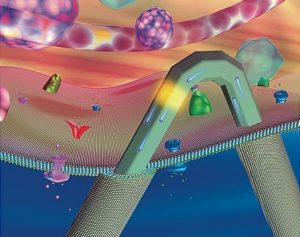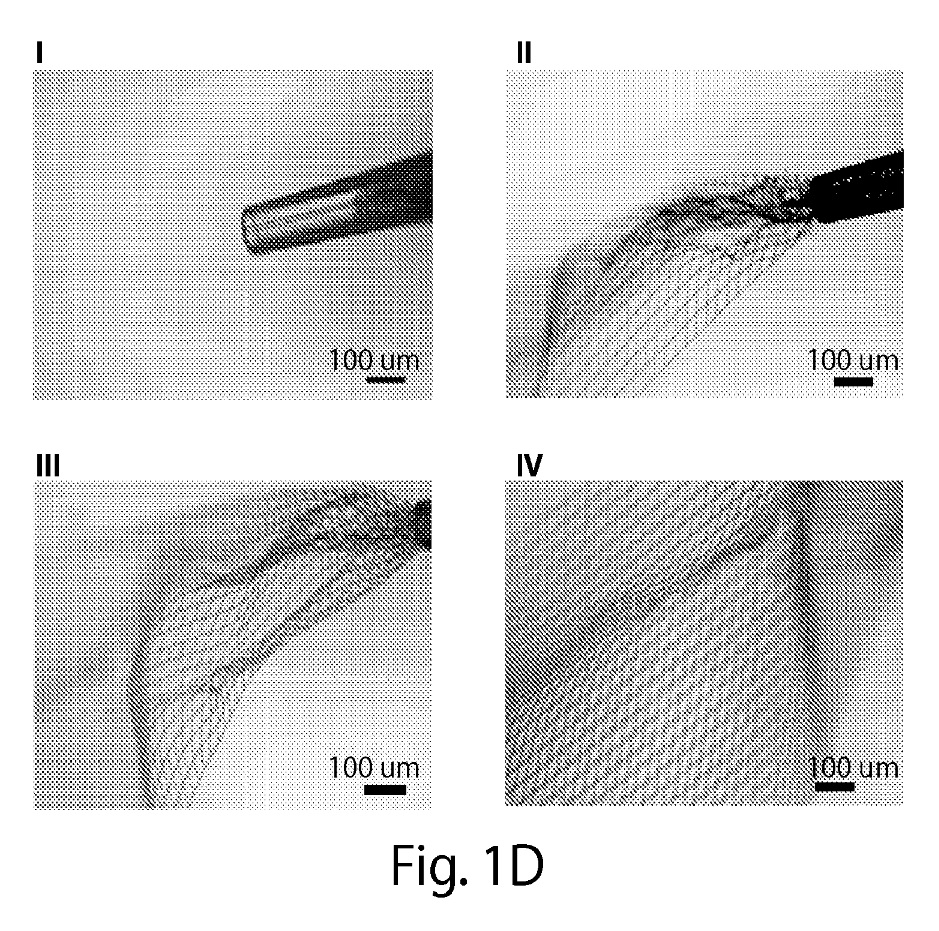
Hyman professor of chemistry Charles Lieber has created a transistor so small it can be used to penetrate cell membranes and probe their interiors, without disrupting function. The transistor (yellow) sits near the bend in a hairpin-shaped, lipid-coated silicon nanowire. Its scale is similar to that of intra-cellular structures such as organelles (pink and blue orbs) and actin filaments (pink strand).
Source:
- December 16, 2010. Jonathan Shaw. “Virus-Sized Transistors.” Harvard Magazine.


https://www.harvardmagazine.com/2011/01/virus-sized-transistors.
University, Magazine.

The present invention generally relates to nanoscale wires and/or injectable devices. In some embodiments, the present invention is directed to electronic devices that can be injected or inserted into soft matter, such as biological tissue or polymeric matrixes. For example, the device may be passed through a syringe or a needle. In some cases, the device may comprise one or more nanoscale wires. Other components, such as fluids or cells, may also be injected or inserted. In addition, in some cases, the device, after insertion or injection, may be connected to an external electrical circuit, e.g., to a computer. Other embodiments are generally directed to systems and methods of making, using, or promoting such devices, kits involving such devices, and the like.
Why Did Harvard’s (now convicted) Charles M. Lieber Create a U.S. Patent for Using 5G Radiation to Vibrate Corona Virus Particles from Preset Nanotubule Containers?
Sources:
- December 30, 2015. Charles M. Lieber, Jia Liu, Zengguang CHENG, Guosong Hong, Tian-Ming FU, and Tao Zhou. Systems and methods for injectable devices. World Intellectual Property Organization WO2015199784A2, filed April 3, 2015, and issued December 30, 2015.

https://patents.google.com/patent/WO2015199784A2,
Local copy.
Patent. - May 31, 2023. Clay Clark with Judy Mikovits. Dr. Mikovits | Vaccine Nanotechnology | Doctor Judy Mikovits Breaks Down the Nefarious Patents | Who Is Developing Vaccine Nanotechnology? What Does Vaccine Nanotechnology Mean? (Read the Patents In the Description). Thrivetime Show: The ReAwakening versus The Great Reset. Runtime: 55:34.

https://rumble.com/v2r7wc0-dr.-mikovits-vaccine-nanotechnology-.html.
Video. - Karen Kingston. “Karen Kingston | Substack.”

https://substack.com/@karenkingston.
Blog.
See also, on this site:
- Posts citing Clay Clark with Judy Mikovits in Doctor Judy Mikovits Breaks Down the Nefarious Patents
]]>

Charles Lieber, the chair of Harvard University’s Department of Chemistry and Chemical Biology, was arrested. He was accused of lying about his contact with the Chinese program, Thousand Talents Plan, which the U.S. has previously flagged as a serious intelligence concern. He invented the virus sized transistors.
Sources:
- January 28, 2020. Bill Chappell. “Acclaimed Harvard Scientist Is Arrested, Accused Of Lying About Ties To China.” National Public Radio [NPR] via WUNC.

https://www.wunc.org/2020-01-28/acclaimed-harvard-scientist-is-arrested-accused-of-lying-about-ties-to-china.
News. - June 15, 2021. Evan Craighead. “FBI Agent Admits to Falsely Accusing Nanotech Research Professor of Being a Chinese Military Spy.” Sputnik International.

https://sputniknews.com/us/202106151083149339-fbi-agent-admits-to-falsely-accusing-nanotech-research-professor-of-being-a-chinese-military-spy/.
News. - July 28, 2020. “Harvard University Professor Charged with Tax Offenses.” U.S. Department of Justice.

https://www.justice.gov/opa/pr/harvard-university-professor-charged-tax-offenses.
Government. - December 21, 2021. Ailan Evans. “Top Harvard Professor Found Guilty Of Lying About Payments From China.” Daily Caller.

https://dailycaller.com/2021/12/21/harvard-university-china-department-of-justice-charles-lieber/.
News.
Related:
- January 6, 2022. Greg Reese. Evidence of Self Assembling Nano Circuitry in the Pfizer Vaccine. Reese Report. Runtime: 6:20.

https://rumble.com/vs28s5-evidence-of-self-assembling-nano-circuitry-in-the-pfizer-vaccine.html.
Video.
See also, on this site:
- Harvard Magazine: Virus-Sized Transistors
- Ricardo Delgado finds what he believes is a micro-router in a Pfizer vial
]]>